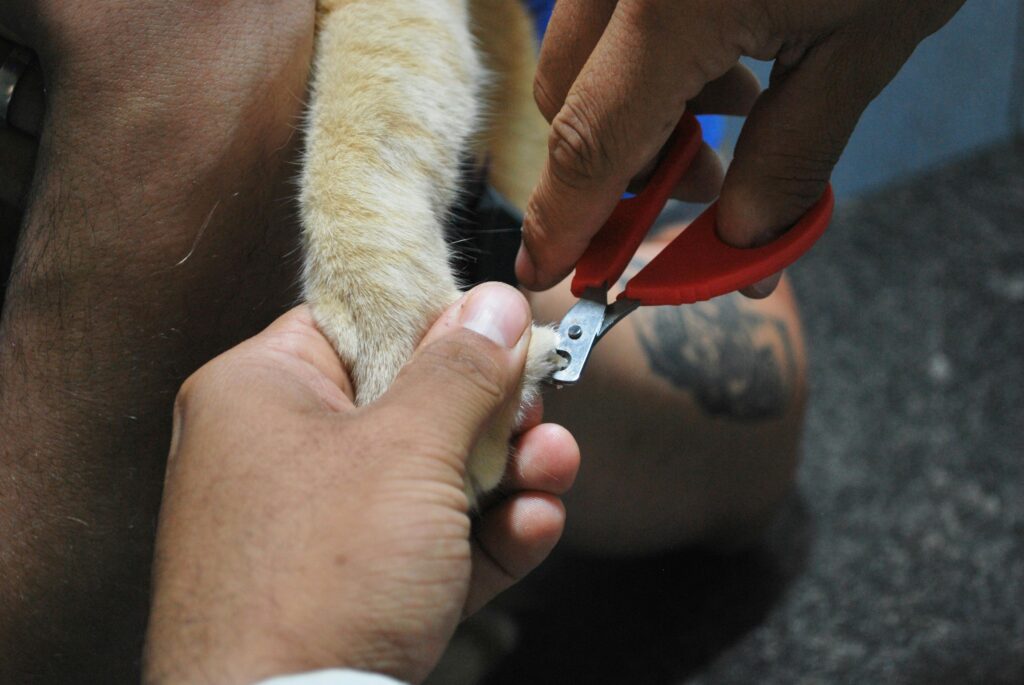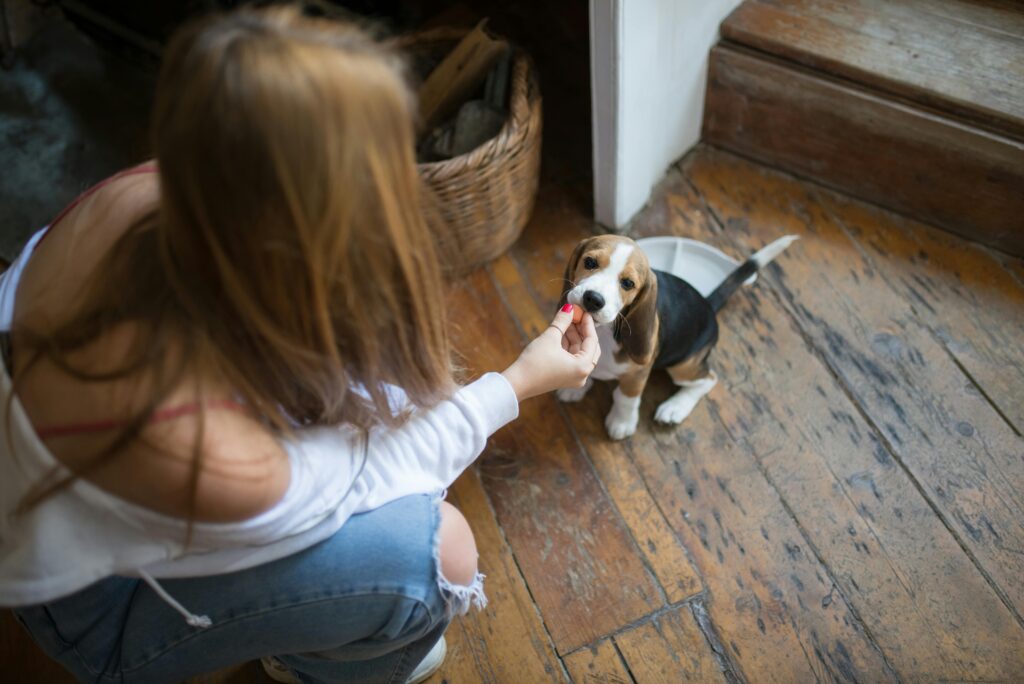A big part of taking care of your pet is cutting its nails. For dogs, cats, and other animals, having long nails can be painful and even be bad for their health. But many pet owners are scared to cut their pets’ nails at home. This guide uses simple words to show you how to safely cut your pet’s nails, step by step. This article will help you confidently trim your pet’s nails, whether you have a pet or not.

Why Nail Trimming Is Important for Pets
Prevents Pain and Discomfort
If their nails get too long, they can hit the floor and push the nail back into their paw. This makes your pet feel pain and pressure. Some cats may change how they walk to avoid pain, which can cause joint problems over time. Cutting your pet’s nails regularly keeps them healthy and comfortable.
Lowers the chance of getting hurt
Pets’ long nails are more likely to break or split, especially when playing. It can hurt to have your nails broken, and they could bleed or get infected. By cutting your pet’s nails regularly, you can keep them from getting hurt and needing to go to the vet.
Helps with posture and mobility
When pets’ nails are properly clipped, they walk better and feel safer moving around. You might slip if your nails are too long, especially on tile or hardwood floors. Taking good care of your pet’s nails can help their balance and make moving around easier.
How Often Should You Trim Your Pet’s Nails?
Watch for Signs of Overgrowth
The nails are too long if you hear clicking sounds when your pet walks on the floor. Trimming your pet’s nails if they touch the ground while standing is time. Check to see if your cat’s claws are getting caught on furniture or linens.
Keep to a regular schedule
Most dogs need to have their nails cut every three to four weeks. Dogs walking on a sidewalk may not need as many trims. The claws of indoor cats may need to be trimmed every two to four weeks, but the claws of outdoor cats may wear down on their own.
Adjust for Age and Lifestyle
Trims may need to be done more often on older pets and pets that do not move around much. Puppies and cats must also trim their nails because they grow so fast. When planning for your pet, consider how it likes to spend time.
What Tools Do You Need for Safe Nail Trimming?
Nail Clippers or Grinders
You can either cut or grind the nails of your pet. There are many types of clippers, such as scissors and blades. Some pets like grinders because they use a spinning tool to smooth the nails. Pick the one that works best for you and your pet.
Powder for clotting or cornstarch
If you cut your nail too short and bleed, you can rapidly stop the bleeding with spiked powder. We can help you if you do not have this. Always keep it close by when you cut your nails.
Treats and Towels
Give your pet treats every time it stays quiet. You can hold small pets gently with a towel or wrap them up to keep them safe. Before you start the fix, make sure your tools and supplies are easy to get to.
Prepare Your Pet for Nail Trimming
Help Them Get Used to the Tools
Before you cut or grind your pet’s nails, let them see, smell, and hear them. This makes people less scared. Tap the tool softly on their paw without trimming it to make them feel more at ease.
Pick the Right Time
Pick when your pet is calm or tired, like after a walk or a game. A tired pet is easier to handle and less likely to fight.
Make It a Positive Experience
If you want to touch someone, be gentle. Give treats before and after the cut. The first few lessons should be short. Make small changes to the number of nails you trim once if your pet stays calm.
Dog nail trimming instructions
Find a Quiet Space
Pick a room that is quiet and well-lit. Put your dog down on a stable mat or non slip rug. Get all of your tools ready before you start.
Carefully hold the paw
Hold one paw at a time and press gently to make the nail longer. Pay close attention to find the nail’s clear part. Stay away from the quick, the pink part inside with nerves and blood vessels.
Cut off a little bit
Cut off a small piece of the tip with the scissors. Cut the nail off just before the pink part if the nail is clear. If the nail is dark, cut it off in small pieces and look for a dark circle. This means you’re getting close to the quick.
Tips for Nervous or Difficult Pets
Start Slow and Stay Calm
Do not cut your pet’s nails all at once. Do it every day until they get used to it. Keep your cool and move slowly so you do not scare them.
You can use treats and distractions
Before and after you cut each nail, give your pet a treat. Some dog owners keep their dogs busy while they trim their nails by putting peanut butter on a spoon or a lick mat.
Ask for Help When Needed
If your pet does not want to be touched, ask someone to gently hold them while trimming. If your cat is hard to groom, hire a professional or ask your vet for advice.
What to Do If You Cut the Quick
Stay Calm and Act Quickly
Your pet may yelp and bleed a little if you cut the quick by mistake. Keep your cool so you do not scare your pet even more. Use a clean cloth to put on styptic powder or cornstarch.
Apply Pressure to Stop Bleeding
Hold the cloth with powder against the nail softly for a few seconds. Most cuts and scrapes heal quickly. Call your vet in 10 minutes if it does not stop.
Give your pet comfort
As soon as the blood stops, comfort and praise your pet. Do not cut that nail for a few weeks so it has time to heal.
Signs Your Pet Needs a Nail Trim
Clicking Sounds While Walking
If your pet’s nails click against the floor, they are too long. One of the best ways to tell when to trim is to look at it.
Curly nails on the side or under the skin
When cats are older, their curled nails can dig into the pads of their feet. This hurts, makes you limp, or leads to diseases. Cut your nails before they start to grow.
Having trouble standing or walking
When your pet’s nails are long, it can change how it stands or moves. If they look in pain, check their paws and think about cutting their nails.
How to Cut Your Other Pets’ Nails
Getting Rabbit and Guinea Pig Nails Snipped
Keeping your pet’s nails clean is important, like rabbits or guinea pigs. Clip their nails with small shears and hold their paws gently. Their nails grow quickly, and too much growth can make it hard for them to move.
Birds’ Nail Care
Birds may need to trim their nails if they do not remove them independently. If your bird is small or wiggly, use special nail scissors made just for birds and ask a professional for help.
Unique Pet Nail Care
Talk to a vet or an expert on unusual pets before getting pets like ferrets, snakes, or hedgehogs. They have special needs, and cutting them off wrong can hurt them.
When to Take Your Pet to a Professional Groomer or Vet
If your pet does not like having their nails trimmed
Some pets never get used to having their nails trimmed. A groomer can cut your pet’s nails quickly and safely, making you feel less stressed.
For Nails That Are Thick or Curled
Don’t try to cut your pet’s nails at home if they are very thick or curled into the paw. A vet or groomer knows how to help and has the right tools.
If You Are not Sure How to trim
Ask a professional where to cut if you are not sure. There are a lot of places that will show you how to safely trim your pet’s nails while you’re there.
How to Make Nail Trimming a Regular Habit
Keep a Nail Care Calendar
Please write it down or set an alarm to remind you to regularly check your pet’s nails. Sticking to a plan keeps things from getting too big and makes trimming easier every time.
Reward Good Behavior Every Time
After every cut, praise your pet and give it a small treat. Giving your pet treats will help it stay calm during future trims.
Stay Patient and Consistent
Your pet will get used to having their nails trimmed, even if they do not like it at first. Be kind, move slowly, and do not change anything. Your pet will learn to trust the process over time.
Conclusion
Keeping your pet healthy and happy is important by safely cutting their nails. You can confidently cut your nails at home with the right tools, plan, and time. Watch out for signs of too much growth, safely trim your pet’s hair, and give them treats along the way. If you are not sure about something, ask a professional for help. Taking care of your pet’s nails does not have to be hard; it can be an easy, regular part of grooming.



